
The Four Seasons is a group of four violin concerti by Italian composer Antonio Vivaldi, each of which gives musical expression to a season of the year. These were composed around 1718–1720, when Vivaldi was the court chapel master in Mantua. They were published in 1725 in Amsterdam, together with eight additional concerti, as Il cimento dell'armonia e dell'inventione.

The Symphony No. 1 in E minor, Op. 39, is a four-movement work for orchestra written from 1898 to 1899 by the Finnish composer Jean Sibelius.

Ludwig van Beethoven's Symphony No. 1 in C major, Op. 21, was dedicated to Baron Gottfried van Swieten, an early patron of the composer. The piece was published in 1801 by Hoffmeister & Kühnel of Leipzig. It is not known exactly when Beethoven finished writing this work, but sketches of the finale were found to be from 1795.

Mendelssohn's Piano Concerto No. 1 in G minor, Op. 25, was written in 1830–31, around the same time as his fourth symphony ("Italian"), and premiered in Munich on 17 October 1831. This concerto was composed in Rome during a travel in Italy after the composer met the pianist Delphine von Schauroth in Munich. The concerto was dedicated to her. Mendelssohn attended one party after another in Munich in October 1831, the month of the premiere, but he also played chamber music and taught double counterpoint. He performed the piece himself at the premiere, which also included performances of his Symphony No. 1 and the Overture from Midsummer Night's Dream. He had already written a piano concerto in A minor with string accompaniment (1822) and two concertos with two pianos (1823–24).

Also sprach Zarathustra, Op. 30 is a tone poem by Richard Strauss, composed in 1896 and inspired by Friedrich Nietzsche's philosophical 1883–1885 novel Thus Spoke Zarathustra. Strauss conducted its first performance on 27 November 1896 in Frankfurt. A typical performance lasts roughly thirty-three minutes.
D major is a major scale based on D, consisting of the pitches D, E, F♯, G, A, B, and C♯. Its key signature has two sharps. The D major scale is:

L'estro armonico, Op. 3, is a set of 12 concertos for string instruments by Italian composer Antonio Vivaldi, first published in Amsterdam in 1711. Vivaldi's Twelve Trio Sonatas, Op. 1, and Twelve Violin Sonatas, Op. 2, only contained sonatas, thus L'estro armonico was his first collection of concertos appearing in print. It was also the first time he chose a foreign publisher, Estienne Roger, instead of an Italian. Each concerto was printed in eight parts: four violins, two violas, cello and continuo. The continuo part was printed as a figured bass for violone and harpsichord.
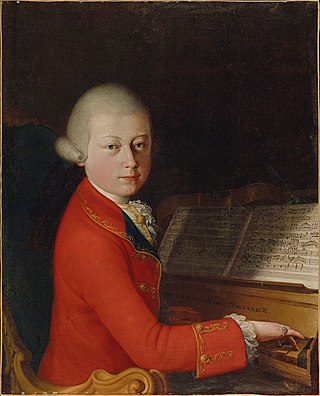
Wolfgang Amadeus Mozart began his series of preserved piano concertos with four that he wrote in Salzburg at the age of 11 : K. 37 and 39–41. The autographs, all held by the Jagiellonian Library, Kraków, are dated by his father as having been completed in April and July of 1767. Although these works were long considered to be original, they are now known to be pasticcios of sonatas by various German composers. The works on which the concertos are based were largely published in Paris, and presumably Mozart and his family became acquainted with them or their composers during their visit to Paris in 1763–64.

La stravaganza [literally 'Extravagance'], Op. 4, is a set of concertos written by Antonio Vivaldi in 1712–1713. The set was first published in 1716 in Amsterdam and was dedicated to Venetian nobleman Vettor Delfino, who had been a violin student of Vivaldi's. All of the concertos are scored for solo violin, strings, and basso continuo; however, some movements require extra soloists.
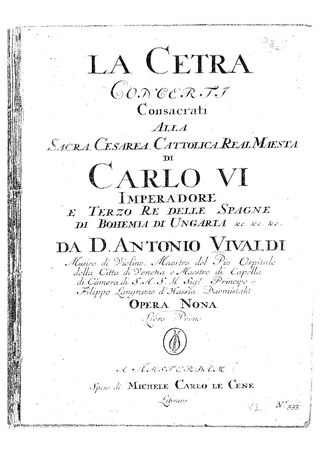
La cetra, Op. 9, is a set of twelve violin concertos by Antonio Vivaldi, published in 1727. All of them are for violin solo, strings, and basso continuo, except No. 9 in B flat, which features two solo violins. The set was named after the cetra, a lyre-like instrument, and was dedicated to Emperor Charles VI.
An organ concerto is an orchestral piece of music in which a pipe organ soloist is accompanied by an an orchestra, although some works exist with the name "concerto" which are for organ alone.
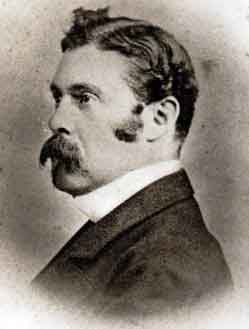
Marie-Alexis de Castillon de Saint-Victor was a French composer.
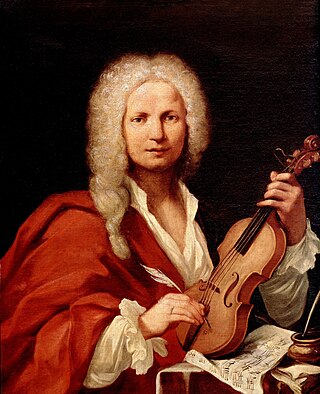
Antonio Vivaldi wrote a set of concerti, Op. 11, in 1729.

The 50 Greatest Pieces of Classical Music is a compilation of classical works recorded by the London Philharmonic Orchestra with conductor David Parry. Recorded at Abbey Road Studios, Royal Festival Hall and Henry Wood Hall in London, the compilation was released in digital formats in November, 2009 and as a 4-CD set in 2011. The 50 Greatest Pieces of Classical Music has sold over 200,000 copies and spent over three days as one of the top 10 classical albums on iTunes.
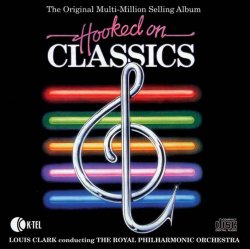
Hooked on Classics, produced by Jeff Jarratt and Don Reedman, is a multi-million selling album recorded by Louis Clark and the Royal Philharmonic Orchestra, published in 1981 by K-tel and distributed by RCA Records, part of the Hooked on Classics series.

Hooked on Classics 2: Can't Stop the Classics is an album by Louis Clark and the Royal Philharmonic Orchestra, published in 1982 by K-tel, part of the Hooked on Classics series.
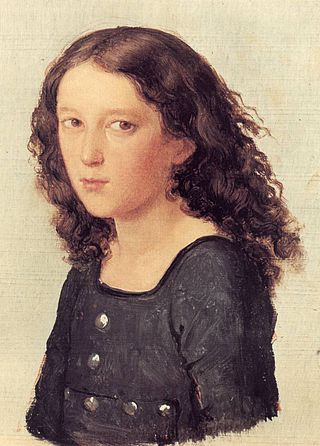
The Concerto for Piano, Violin, and Strings in D minor, MWV O4, also known as the Double Concerto in D minor, was written in 1823 by Felix Mendelssohn when he was 14 years old. This piece is Mendelssohn's fourth work for a solo instrument with orchestral accompaniment, preceded by a Largo and Allegro in D minor for Piano and Strings MWV O1, the Piano Concerto in A Minor MWV O2, and the Violin Concerto in D minor MWV O3. Mendelssohn composed the work to be performed for a private concert on May 25, 1823 at the Mendelssohn home in Berlin with his violin teacher and friend, Eduard Rietz. Following this private performance, Mendelssohn revised the scoring, adding winds and timpani and is possibly the first work in which Mendelssohn used winds and timpani in a large work. A public performance was given on July 3, 1823 at the Berlin Schauspielhaus. Like the A minor piano concerto (1822), it remained unpublished during Mendelssohn's lifetime and it wasn't until 1999 when a critical edition of the piece was available.

The Concerto in C major, RV 558, otherwise known as "Concerto for Diverse Instruments" is an orchestral work by Antonio Vivaldi, written around 1740, with its premiere on 21 March of that year.














